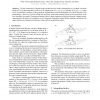Free Online Productivity Tools
i2Speak
i2Symbol
i2OCR
iTex2Img
iWeb2Print
iWeb2Shot
i2Type
iPdf2Split
iPdf2Merge
i2Bopomofo
i2Arabic
i2Style
i2Image
i2PDF
iLatex2Rtf
Sci2ools
113
Voted
GEOINFO
2003
2003
A Strategy for the Interpolation of Surfaces through the Use of Basis Functions
For the construction of digital terrain models based on surface interpolation, it is defined a bivariate function ¡£¢¥¤§¦©¨ that interpolates a finite set of sample points, § ¢¤ ¦©¨ ¦ , such that, ¡£¢¤ ¦¨ . In this work, it is presented a strategy for the generation of interpolation surfaces through the use of basis functions. This methodology is based on a work by Chaturvedi and Piegl, where improvements related to the construction of the basis functions were made. The proposed strategy allows a larger expansion of the basis function’s support region, represented by the interior of a trajectory curve, composed of quadratic rational Bézier segments and reduces the approximation error between the reference surface and the interpolation surface.
Related Content
| Added | 31 Oct 2010 |
| Updated | 31 Oct 2010 |
| Type | Conference |
| Year | 2003 |
| Where | GEOINFO |
| Authors | Edson Ricardo de Andrade Silva, Creto Augusto Vidal, Joaquim B. Cavalcante Neto |
Comments (0)

